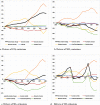A critical analysis of the impacts of COVID-19 on the global economy and ecosystems and opportunities for circular economy strategies
- PMID: 32982059
- PMCID: PMC7505605
- DOI: 10.1016/j.resconrec.2020.105169
A critical analysis of the impacts of COVID-19 on the global economy and ecosystems and opportunities for circular economy strategies
Abstract
The World Health Organization declared COVID-19 a global pandemic on the 11th of March 2020, but the world is still reeling from its aftermath. Originating from China, cases quickly spread across the globe, prompting the implementation of stringent measures by world governments in efforts to isolate cases and limit the transmission rate of the virus. These measures have however shattered the core sustaining pillars of the modern world economies as global trade and cooperation succumbed to nationalist focus and competition for scarce supplies. Against this backdrop, this paper presents a critical review of the catalogue of negative and positive impacts of the pandemic and proffers perspectives on how it can be leveraged to steer towards a better, more resilient low-carbon economy. The paper diagnosed the danger of relying on pandemic-driven benefits to achieving sustainable development goals and emphasizes a need for a decisive, fundamental structural change to the dynamics of how we live. It argues for a rethink of the present global economic growth model, shaped by a linear economy system and sustained by profiteering and energy-gulping manufacturing processes, in favour of a more sustainable model recalibrated on circular economy (CE) framework. Building on evidence in support of CE as a vehicle for balancing the complex equation of accomplishing profit with minimal environmental harms, the paper outlines concrete sector-specific recommendations on CE-related solutions as a catalyst for the global economic growth and development in a resilient post-COVID-19 world.
Keywords: COVID-19; Circular economy; Climate change; Supply chain resilience; Sustainability; Sustainable development.
© 2020 Elsevier B.V. All rights reserved.
Conflict of interest statement
None.
Figures











References
-
- Abbas Elmualim S.M., Chileshe N., Rameezdeen R. Construction and the circular economy: smart and industrialised prefabrication. Unmak. Waste Product. Consump. 2018:323.
-
- ACI Policy Brief – COVID-19: Relief measures to ensure the survival of the airport industry. Airport Council Int. 2020
-
- Acquaye A., Feng K., Oppon E., Salhi S., Ibn-Mohammed T., Genovese A., Hubacek K. Measuring the environmental sustainability performance of global supply chains: A multi-regional input-output analysis for carbon, sulphur oxide and water footprints. J. Environ. Manag.187. 2017:571–585. - PubMed
-
- Air Transport Bureau . International Civil Aviation Organization (ICAO); Montréal, Canada: 2020. Effects of Novel Coronavirus (COVID‐19) on Civil Aviation: Economic Impact Analysis.
LinkOut - more resources
Full Text Sources
Other Literature Sources
